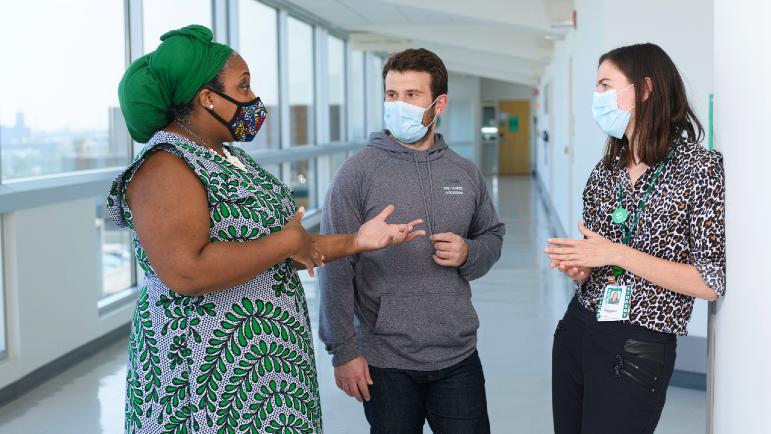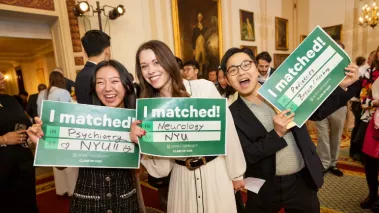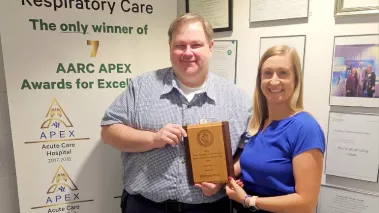Physicians and medical students are passionate about keeping people healthy. Turns out, many are interested in assessing and mending the educational curriculums that train them, too.
Rush Medical College students can participate in leadership positions on curriculum committees, giving them the opportunity to work alongside faculty and have a direct impact on medical education at Rush. Jake Schulman, a 2021 graduate of Rush, and Amy Napleton, a current fourth-year student, were instrumental in shaping the role of students on the curriculum committees that were formed with the flipped classroom curriculum model integrated in curriculum in 2017.
Both students have a passion for curriculum development. Schulman decided to pursue a Master of Health Professions Education at University of Illinois at Chicago through the Medical Education Scholarship Program offered by his residency program at the University of Chicago. Napleton, a fourth-year medical student planning to specialize in family medicine, came to medical school with a master’s in secondary education and prior teaching experience.
Tell us about the curriculum committee.
Amy Napleton: The Committee on Curriculum and Evaluation (CCE) is the overarching curriculum committee for Rush Medical College and includes faculty and administrators. There are three subcommittees with student representation and an independent Student Curriculum Advisory Committee (SCAC). That is a student-only committee that is the main student voice for influencing the curriculum.
Jake and I were on both committees to provide the student perspective and voice to the bigger picture. These committees evaluate and adapt courses each year or look at new courses that are entering the curriculum, both for the pre-clerkship and clerkship stages.
Jake Schulman: The larger committee includes a chair, a vice chair, eight faculty members and three student members, all charged with overseeing the inner workings of the subcommittees.
How can students provide input about a course or the curriculum?
JS: All student feedback is discussed at CCE so the committee can evaluate it and vote on changes. The best way for students to offer feedback is to either go through the Student Curriculum Advisory Committee or speak directly to an RMC administrator, who can present the issue to the CCE, if appropriate.
AN: Every year after a course is completed, it goes through a course evaluation process that includes a student and a few faculty members who weren't involved with the course so they can be impartial observers.
A student on the subcommittee participating in a course review provides anonymous feedback. When it comes time to review the course with faculty, the student will have contributed to the action items needed to change in the next iteration of that course. While this happens at the subcommittee level, the executive committee makes the final decision whether to approve those action items and the course review.
Jake and I contribute to both processes, participating in the micro and macro levels, to see these changes successfully complete the review.
How did you both first get involved with the curriculum committees?
AN: Prior to med school, I taught seventh and eighth grade science through Teach For America. While I’ve always wanted to be a doctor, I liked education a lot and wanted a role in curriculum development during my medical education that could continue into my eventual career. In every side of medicine, there are many opportunities for teaching.
SCAC existed when I was a first-year student because Jake’s class had invented it, and each of the eight small M1 groups within SCAC elected a member to our SCAC. So, I was elected by my class and went on to serve that M1/M2 year. Now, I've continued in the M3/M4 group for SCAC as well.
JS: For me, I had no education background. My class was the first to experience the new flipped curriculum. About a month into my first year, there were a lot of bugs within the curriculum rollout, so students came together to form this student committee.
We had no idea what we were doing. We just knew we needed to have some student representation and voice to bring to the administration to tell them where improvements could be made.
We had some great mentors to kick off the committee, including Dr. Bob Leven. Eventually, the students were all part of the curriculum team. In the last four years we've expanded the team to include a student curriculum advisory committee for each of the four medical school classes.
Also, Amy and I were elected by the CCE to be student representatives on that overarching committee alongside SCAC.
How did the committees play a role in the transition to online learning when the COVID-19 pandemic began?
JS: Our class was wrapping up our third year of medical school and preparing for the pivotal fourth year, which is the most crucial time in medical school. When everything changed due to the pandemic, we already had this group established and were meeting every few weeks with Dr. Aimee Szewka, the assistant dean of clerkship education.
Dr. Szewka then offered to meet weekly to troubleshoot and brainstorm until we could find a stable and equitable solution to ensure that both the rising fourth- and third-year students were able to complete the clinical experiences necessary to graduate and be ready for residency.
AN: Also, I was called on by some of the assessment team to help produce a plan on how to take assessments virtually for the pre-clerkship curriculum. We worked to make sure that the pre-clerkship classes, which are normally within the flipped classroom, could continue to be just as highly interactive and meaningful over Zoom.
What was it like confronting the obstacles COVID-19 posed for the medical college after your experience shaping the flipped classroom?
JS: I learned that my perspective was never an accurate representation of my entire class’s experiences, wants and needs.
Opinion varied about what the best solutions could have been, but no answer ever satisfied the entire class. I can understand why. It seems like things have improved since then, but the first 16 to 18 months were challenging, to be completely honest.
This was a lesson in leadership to learn how to make decisions that are best for the entire cohort.
What are your thoughts about the flipped classroom curriculum overall?
AN: Because I come from a place of inquiry-based science education for middle schoolers, I am an advocate for a flipped classroom model in pre-clerkship medical education.
It's not like we grow up and become better at listening to lectures, passively learning and taking notes. It’s an analogy in models of inquiry — the flipped classroom is based on that learning coming from a place of discomfort, identifying the unknown and putting some guesses out there.
There are a lot of great reasons to come to Rush as an incoming medical student. For me, the flipped classroom was one of them. This approach can be new and uncomfortable for some teachers and learners, though. In either role, it requires a shift in mindset to take this curriculum on.
JS: The early stages of the new curriculum made us better self-directed learners. Most importantly, though, it made us stronger learners for our third and fourth years. When you show up third year and feel semi-competent and know what you don't know, can you figure out how to learn what you don’t know? Our first two years built our confidence in that capacity.
Why is it important for students to participate in the curriculum committees?
AN: Students can provide a different and necessary perspective because we experience every single part of the curriculum as we progress through medical school. A lot happens behind the scenes. Getting students back there keeps everything relevant and aligned with the ultimate goal of taking a bunch of premeds and turning them into good doctors.
JS: This opportunity is a catalyst to figure out where else you want to take your career. It’s easy to come to Rush, become a great clinician and match into a great residency, but having these opportunities opens doors and your eyes to what exists beyond Rush. If you want to be involved with scholarship, leadership or advocacy, this opportunity will help you realize what's possible.
I've also taken a lot from my interactions with different administrators and faculty members who have shaped me as a person as much as into the physician and educator I'm going to be. My advice for the students coming to Rush is to apply emphasis from day one on forming meaningful relationships with the people who are going to invest a lot of time and effort back into you and help you grow.
What are you most proud of during your time working with them?
JS: This is going to be cheesy, but I think it's working with cool people like Amy. While I can’t produce all the right answers by myself, it was reassuring to work with fellow students and administrators who think outside of the box, innovatively and collaboratively, to develop solutions with the best intentions. That motivates me to continue doing this work as an alternative to sitting back in an office trying to come up with the answers alone.
AN: I completely agree. Building relationships with other passionate students and faculty who have shaped their careers around education has emboldened me, too — feeling like I can speak up when the status quo doesn't make sense or something isn't as fair as it could be. I feel emboldened to do so because, as Jake said, I believe in the work and intentions of the people who we’ve worked with. This is a great opportunity for students interested in academic medicine, advocacy work and student development.
Contact Joanna Kuppy, MD, chair of the Committee on Curriculum and Evaluation, for more information.







